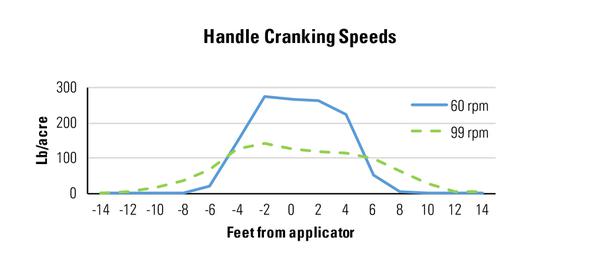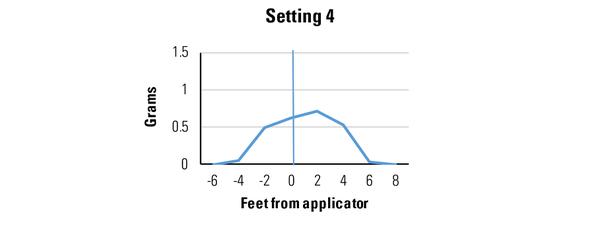Weed management in nursery crops can be one of the most costly components of crop production. Producers of container nursery crops rely primarily on two methods of weed control—multiple applications of preemergence herbicides and hand-weeding. Regardless of which herbicide is applied, the product must be applied accurately and uniformly to achieve effective weed control and to avoid over-application, which may injure crops. Most preemergence herbicides used in container nurseries are formulated on granular carriers. The standard application method is with a hand-held, hand-cranked “belly-grinder” type of rotary spreader. Two of the more commonly used models are the Warren T7-II and the Solo 421S, but other models are available.
The uniformity of spread using these devices has been shown to be quite variable (Figure 1). We have measured granular herbicide applications at nurseries and found up to 250% variability from one pot to another within a container block. Increasing the uniformity of herbicide distribution will improve weed control and decrease the potential for crop damage (Figure 2). When using these granular spreaders, the most important factors affecting the distribution pattern and dose include: walking and cranking speed, swath width, rudder setting, amount of granule in the hopper, spreader output setting, wind speed, and walking patterns.
Granular Distribution Patterns
Granular spreaders typically have a distribution pattern in which the largest amount of granules is deposited directly in front of the applicator, with lesser amounts falling to the sides (Figure 3a). To apply a uniform amount over an area, some overlap between passes is required. Overlapping each side of the distribution pattern by 30 to 35% for a total of 60 to 70% overlap creates the most even application (Figure 3b). How close together the passes are, and as a result how much the passes overlap, is called the effective swath width.
Walking and Cranking Speed
The amount of granules applied to a given area is influenced by the applicator’s walking speed. The faster you walk, the fewer the granules put out (Figure 4). A comfortable speed for most people is 3 mph, or 100 feet in 23 seconds. How fast you turn the spreader crank also influences the distribution of granules (Figure 5). When calibrating your spreader, make sure to use a speed that is comfortable. Then be consistent. You may use a metronome (Figure 6) to maintain constant walking and handle-cranking speeds. When using a metronome, try 99 to 103 beats for the walking speed and 60 for the handle-cranking speed.
Swath Width
The distance between passes with a granular spreader (the swath width) has a large impact on application uniformity. For instance, with a 12-foot swath width, the average distribution pattern of FreeHand granules using a Warren T7-II spreader is very uneven (Figure 7). The gaps can be greatly reduced by using an 8-foot swath width instead (Figure 8). A swath width of about 8 to 10 feet works best for the average granule carrier.
Rudder Setting
Some spreaders can be adjusted to throw granules more to the right or the left, reducing the amount of product applied outside the container beds (Figure 9). However, using these rudder positions creates spikes in the amount of product applied to the outer edge of the application area (Figure 7, Figure 8, and Figure 10). This can be avoided by using only the center rudder position on spreaders with multiple rudder options (Figure 11). Holding the spreader at an angle while using the center rudder position also creates spikes in application and is not recommended.
Amount of Granule in Hopper
The amount of product in the hopper at any given time affects the rate of application. Application rates can be as much as 45% lower when the hopper is only 10% full than when the hopper is completely full. Don’t wait until the spreader is empty to refill. Add more granules when the level in the hopper drops to about 25% full (Figure 12).
Start Walking Before You Begin Spreading
Start walking and cranking the handle before opening the hopper. Otherwise, the spreader tends to drop a large amount of granules at the beginning (Figure 13). Waiting to open the hopper also helps prevent the spreader from jamming and dropping granules in one spot.
Wind Speed
If there are greater than 5 mph winds, do not use the granular spreader. Wind interferes with the uniformity of application. In Figure 14, notice how wind blew granules to the edge of the pot. This will inhibit root growth where the excessive herbicide is deposited and provide poor weed control where little or no herbicide is present.
Application Pattern (The Direction You Walk Can Make a Difference)
Applicators commonly walk a back-and-forth pattern (up one side and back the other) (Figure 15). This pattern provides an acceptable, balanced distribution (Figure 16a) only when the spreader is fully open (setting 6 on the Warren T7-II or Solo 421S spreaders), and only with a few herbicide granules (notably the clay granule used to make FreeHand G and Pendulum 2G). The fully opened setting may be appropriate for some herbicide applications, but lower settings are often required to achieve the desired application dose. When the lower settings are used, the distribution pattern is skewed more to the right (Figure 16b). This will dramatically affect the uniformity of application (see Figure 17a).
There are two ways to compensate for this skewed pattern—change the direction of travel, making all applications while walking in the same direction (Figure 18a), or make two passes over the same path in opposite directions (Figure 18b). If you have calibrated your spreader to apply the full dose in one pass, then applicators must walk in the same direction (Figure 18a). This might be most easily accomplished by having multiple applicators working together. Alternatively (and preferably), calibrate your spreader to apply half the target dose and walk the area twice in opposite directions (Figure 18b). Remember—if you make two passes over the same path, you must calibrate your spreader to apply only half of the labeled dose each time.
Calibration
It is also important to know how much product your spreader is putting out. Great uniformity will still produce poor results if you’re putting out too much or too little product. Test your application rate and adjust your walking speed and spreader setting as needed. More details on calibration can be found in Calibrating Hand-Held Granular Spreaders for Nursery Weed Control.
Tips for using Warren T-7 II and Solo 421S spreaders
- Maintain a consistent walking speed. Use a metronome.
- Maintain consistent cranking speeds. Use a metronome.
- The size of the beds matters! Keep nursery beds between 6 and 8 feet wide (for an 8- to 10-foot swath width).
- Only use the center rudder position. Do not hold the spreader at an angle.
- Refill the hopper when the level drops to about 25% full. Don’t wait until it runs out.
- Start walking and cranking before opening the hopper.
- If the wind is 5 mph or more, don’t make the application. Wait for a calmer day.
- When using lower spreader settings, spread granules using the single direction, parallel pass method.
- Calibrate your spreader!
Acknowledgement
This publication was made possible by funding from the Southern IPM Enhancement Grant Program.
Publication date: Nov. 18, 2016
AG-826
Recommendations for the use of agricultural chemicals are included in this publication as a convenience to the reader. The use of brand names and any mention or listing of commercial products or services in this publication does not imply endorsement by NC State University or N.C. A&T State University nor discrimination against similar products or services not mentioned. Individuals who use agricultural chemicals are responsible for ensuring that the intended use complies with current regulations and conforms to the product label. Be sure to obtain current information about usage regulations and examine a current product label before applying any chemical. For assistance, contact your local N.C. Cooperative Extension county center.
N.C. Cooperative Extension prohibits discrimination and harassment regardless of age, color, disability, family and marital status, gender identity, national origin, political beliefs, race, religion, sex (including pregnancy), sexual orientation and veteran status.






















